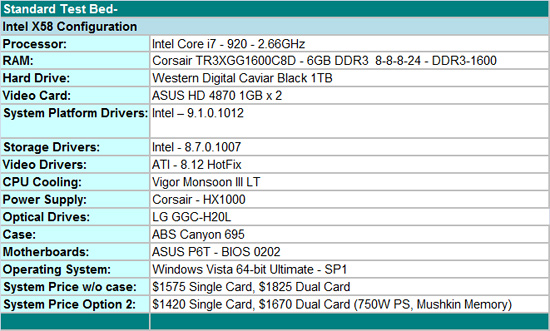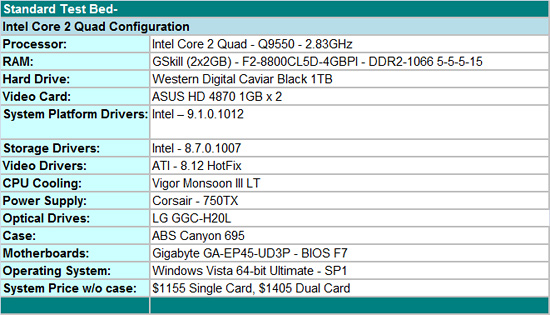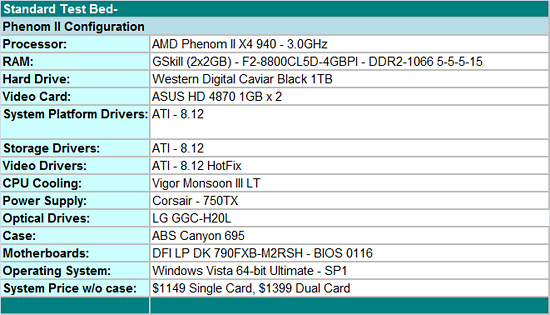CrossFireX and the Phenom II X4 940 – Competitive or Not?
by Gary Key on February 2, 2009 12:00 AM EST- Posted in
- Motherboards
Test Setup
Fortunately for us, during motherboard testing we test SLI or CrossFireX solutions extensively. However, we do not test the graphics cards in the same manner as we do in a GPU review. During motherboard testing, we focus on ensuring compatibility, identifying any layout problems, and checking performance deltas between motherboard chipsets. Instead of running absolute GPU intensive settings, we seek a balance between playable settings, quality, and platform performance. This means reasonable resolutions and 2xAA/8xAF settings to keep the GPU from being a limiting factor where possible. We think these quality settings are fine for most users, especially in FPS games where the differences between 2xAA, 4xAA, or 8xAA are minimized due to the speed of the game.
We run our benchmarks at two of the most popular resolutions for new systems, which happen to be 1680x1050 and 1920x1200. We mention this now as our overview of CrossFireX performance will not have 2560x1600 at 4xAA/16xAF results or tri-card setups. The population of 30” monitors is rather small and except for Crysis, tri-card performance is generally worse than dual card performance with our midrange setups. Consider this review a snapshot of CrossFireX performance with one particular GPU selection as we will not be looking at other ATI cards except the HD4870 1GB.
As such, our test systems today are platform oriented based on similar components and overall pricing schemes between the Intel Core 2 Quad and AMD Phenom II platforms. We selected a “budget” Core i7 setup that is capable of both SLI and CrossFire to ensure platform consistency when we look at SLI performance shortly.



Our Phenom II and Intel Core 2 Quad platforms are within $6 of each other. We fully realize the pricing of the Phenom II X4 940 competes with the Intel Core 2 Quad Q9400, not Q9550, but we are looking at platform costs here. Of course, we could debate the various component choices for several pages and yes, the platform costs could shrink on either side. We did not use rebates in our pricing and all costs were gathered from Newegg on 1/29/09. We think our selections offer the best blend of price, performance, compatibility, and quality right now.
Our decision to go with a 790FX/SB750 combination on the AMD side is strictly based upon performance. The 790FX is about 3%~5% faster on average than comparable 790GX products. AMD continues to recommend the 790GX/SB750 as the platform of choice for the AM2+ and upcoming AM3 products. We disagree from a performance viewpoint; the 790FX/SB750 combination is simply the best choice in our opinion. Of course you will typically pay about $35~$40 or greater for the 790FX boards, but if you intend on running CrossFireX, we think it is worth the additional cost.
On the Intel side, we decided to go with the P45 chipset as it offers a very balanced blend of performance and value. The Gigabyte GA-EP45-UD3P is a superb CrossFire capable motherboard that also happens to be one of the best overclocking S775 products around. The P45 offers dual PCI Express x8 operation in CrossFire mode compared to dual x16 on the 790FX, X48, and X58 boards. However, we did not notice any performance differences between dual x8 and dual x16 operation when comparing the P45 to the X48 in offline testing utilizing our resolutions and quality settings.
The i7 setup can be cost reduced and we did offer a cost improved option by switching out the power supply and memory for equal alternatives. If you are only interested in CrossFire capability on the i7, the motherboard cost can be reduced another $45 and if memory overclocking over DDR3-1800 is not important, then memory costs (DDR3-1600 6GB HP kits) can be reduced another $40 on average. This would bring the i7 platform cost down to $1335 for a single video card configuration without too much of a problem.
Our standard power consumption results with the i7 boards utilized the Corsair HX-1000 power supply and our P45/790FX boards used the Corsair 750W power supply. We are qualifying the Corsair 750TX (and other under 1000W units) on the i7 platform currently. However, we did complete our benchmark runs today on the i7 with the Corsair 750TX. We will provide additional power consumption and temperature results based on these changes shortly.
We selected the ASUS EAH4870 DK/HTDI/1GD5 video card. It is a non-reference design that offers improved thermals and acoustics over the standard HD4870 1GB cards on our board choices. We think if a user is going to run CrossFireX on one of these platforms, then the best possible performance choice is the HD4870 1GB. Depending upon pricing on the HD 4870 1GB cards, a 4870X2 might be a better choice for most users.
The WD Caviar Black 1TB is our hard drive of choice for storage purposes. LG’s Blu-ray playback capable drive fills in for optical duties. We purchased two of G.Skill's impressive DDR2-1100 4GB kits that operate at speeds up to DDR2-1240 on our boards with about 2.1V of VDimm. We used 4GB in our Phenom II and Core 2 Quad systems with memory set at DDR2-1066 with 5-5-5-15 timings at 1.8V. Our DDR3-1600 6GB kit is from Corsair and was dialed in at DDR3-1600 with 8-8-8-24 1T timings at 1.60V. Vigor provided their Monsoon III LT CPU cooler that offers mounting kits for the 1366, 775, and AM2+ processors. ABS provided their Canyon 695 case and it has proved to be exemplary during testing.
Our game selections are a few of the recent top selling titles. Certain titles that are capped at 30FPS like Command and Conquer Red Alert 3 or do not benefit from CrossFireX (Flight Simulator X) were not included. We tested Grand Theft Auto IV with the latest 1.02 patch but still have a couple of unanswered anomalies on the i7 platform. Those results are not available today.
We are also including results with our processors overclocked for CrossFire only. Overclock results with a single card configuration provided little benefit in most cases. Simply overclocking the video cards resulted in better performance numbers than overclocking the processors with this configuration. That is a story for another time. The Phenom II 940 is running at 3.95GHz (17.5x226, DDR2-1205, 5-5-5-18, NB Speed 2486Mhz ), Core 2 Quad Q9550 at 4.25GHz (8.5x500, DDR2-1000, 5-4-4-12), and the Core i7 920 at 4GHz (20x200, DDR3-1600, 8-8-8-24). These were the maximum stable overclocks on air-cooling that we could sustain in a 24/7 setup with Vista Ultimate 64 SP1.










68 Comments
View All Comments
balancedthinking - Monday, February 2, 2009 - link
If these Settings were used for the Phenom II 940, at least it is not as bad as I first thought:http://www.anandtech.com/weblog/showpost.aspx?i=55...">http://www.anandtech.com/weblog/showpost.aspx?i=55...
That would mean an NB frequency around 2450. That is quite okay though it can be tweaked a bit further.
Still, it would be nice to know which settings were actually used for the Phenom II.
hooflung - Monday, February 2, 2009 - link
That is a very, very well done article. Keep it up guys. Can't wait til' income tax and I am going to get a e8500 and a pII 940 to upgrade my P35 and 790GX, respectively.7Enigma - Monday, February 2, 2009 - link
Thank you for finally including this information in the charts!This has been a HUGE peev of mine for a while now and it really helps to see which card (or in this case system) is actually better than the other at a particular game where the average frame rate may not tell the whole story.
Please make sure the rest of the Anandtech crew starts using this format for future testing.
CPUGuy - Monday, February 2, 2009 - link
Although I understand the intent of using the highest OC possible I do believe the results can lead to another conclusion. A few of us discussing the CPU OC, CF results. It appears (so far) that the reason why the Q9550 came out ahead in CF results was a direct result of it's overclock. Some believe that if the PII 940 was OC'd that high (yes we read the other article about this) or the Q9550 was OC'd down, results would be different.The reason for this point of view is that most are not able to get Q9550 at 4.25GHz on air.
jusme - Monday, February 2, 2009 - link
I found this article very informative. It now puts into perspective where the PII 940 stands in the gaming arena. Thanks Anandtech for taking the time to do it. I myself have 3 computers, 2 capable of of either the quad 9550(P45) or PII 940 Deneb(780g). It is very good to know that which ever solution I choose, xfire on P45 or single on 780g, I know the performance capabilities of both, and I like both. Hell, you got that Q9550 up to 4.05 oc for these tests? Wow! I knew they were capable, but to run these games that well under the load is alone impressive. You sure it was'nt the Q9650? I alone was going to shoot for a modest 3.8 for gaming, stability and temp management. In closing, it is also good to know that those who jumped on the I7 bandwagon real fast are sitting pretty, I know it was'nt cheap, but alot of those builders skimped on graphics.zenguy - Monday, February 2, 2009 - link
In your review, it you stated that your testing did not reveal any difference between the P45 and P48 for CrossFire Limits so a P45 board was chosen.However, based on a few other reviews I have read, the 4850 can be noticably limited by the P45 board and ergo I presume the limits on a 4870 1GB card would be much much higher.
An example of one such review is below...........
http://www.tweaktown.com/articles/1472/10/intel_p4...">http://www.tweaktown.com/articles/1472/...s_x48_cr...
Could this explain the "Unusual Drop" in performance or unexpected low framerates for the Intel Platform that you noted?
AtenRa - Monday, February 2, 2009 - link
I am 100% sure that the results of the Core 2 Quad 9550 wild be much higher with an Intel X48 chipset than with the P45 in Cross Fire.Never the les, the article DOES show that Phenom II 940 is competitive in real life gaming at High resolutions.
zenguy - Monday, February 2, 2009 - link
Yes the PII is a valid solution.AMD Finally re-entered the game in my Mind with the release.
SLI - Monday, February 2, 2009 - link
Hammonds famous line in Jurrasic Park.Indeed, for 95% of folks, these ultra high benchmarks are useless. But for those of us in the 5%, thesy serve as a reminder on the ridiculous amounts of money we spend to squeeze just tha extra few FPS out. But then again the other 95% just dont get it...why?
Here is a paragraph I have kept near and dear for some years and it explains it eloquently.
"To upgrade or not to upgrade, that is the question that crosses many enthusiasts' lips on a daily basis. The upgrade bug is a high infectious, wallet-stripping disease that spreads fast once it gets a hold of you. Hardware manufacturers propagate this infection by offering you, the consumer, faster, more desirable hardware each month. Almost every facet of the hardware world begs you to get the next model up, or to break open the piggy bank and buy an 'upgraded version' of what you already have. Speak to a number of enthusiasts and they'll tell you that upgrading is more addictive than gambling (Biz387, 2003)."
So, you see, it's not our fault. Were simply sick. I type this as I play crysis at DX10 Very High spec everything at maximum @ 1900x1200@ 40fps average. Pulling about 830watts at the outlet, lol.
CPUGuy - Monday, February 2, 2009 - link
If I were to use your number, the inclusion of more mainstream benchmark results pulls in nearly 95% more hits to this website then it would be beneficial for both anandtech and it's viewer base. Puts things into prospective doesn't it? LOL